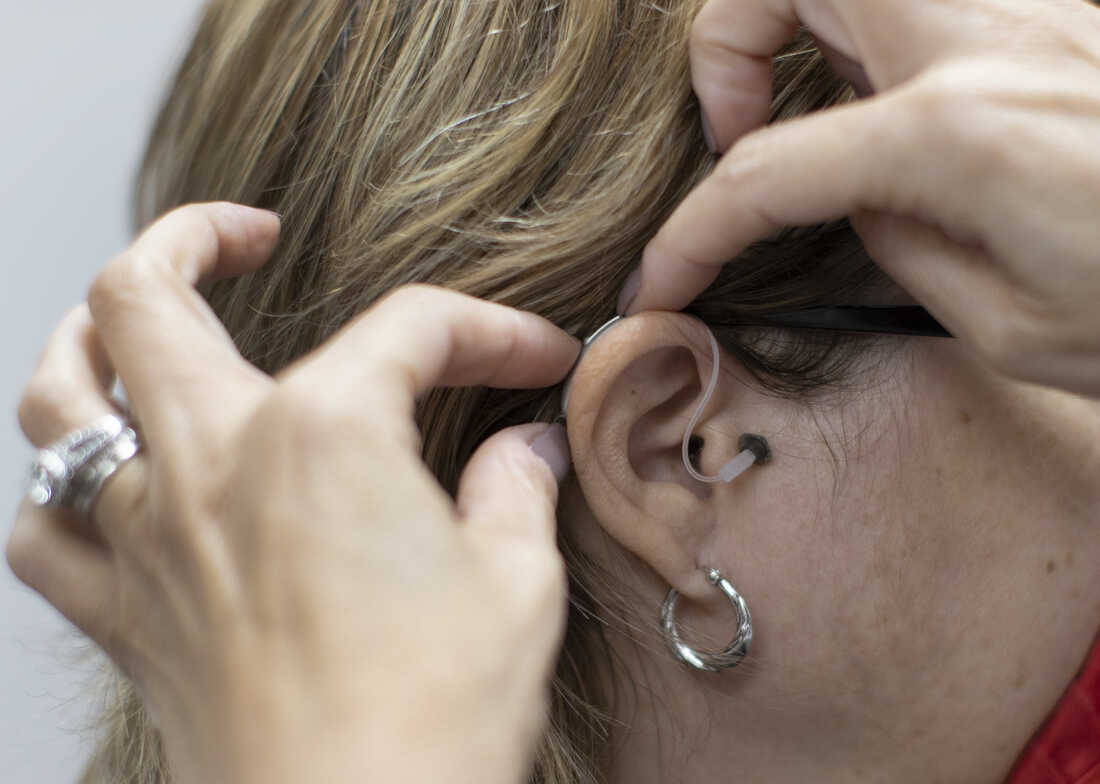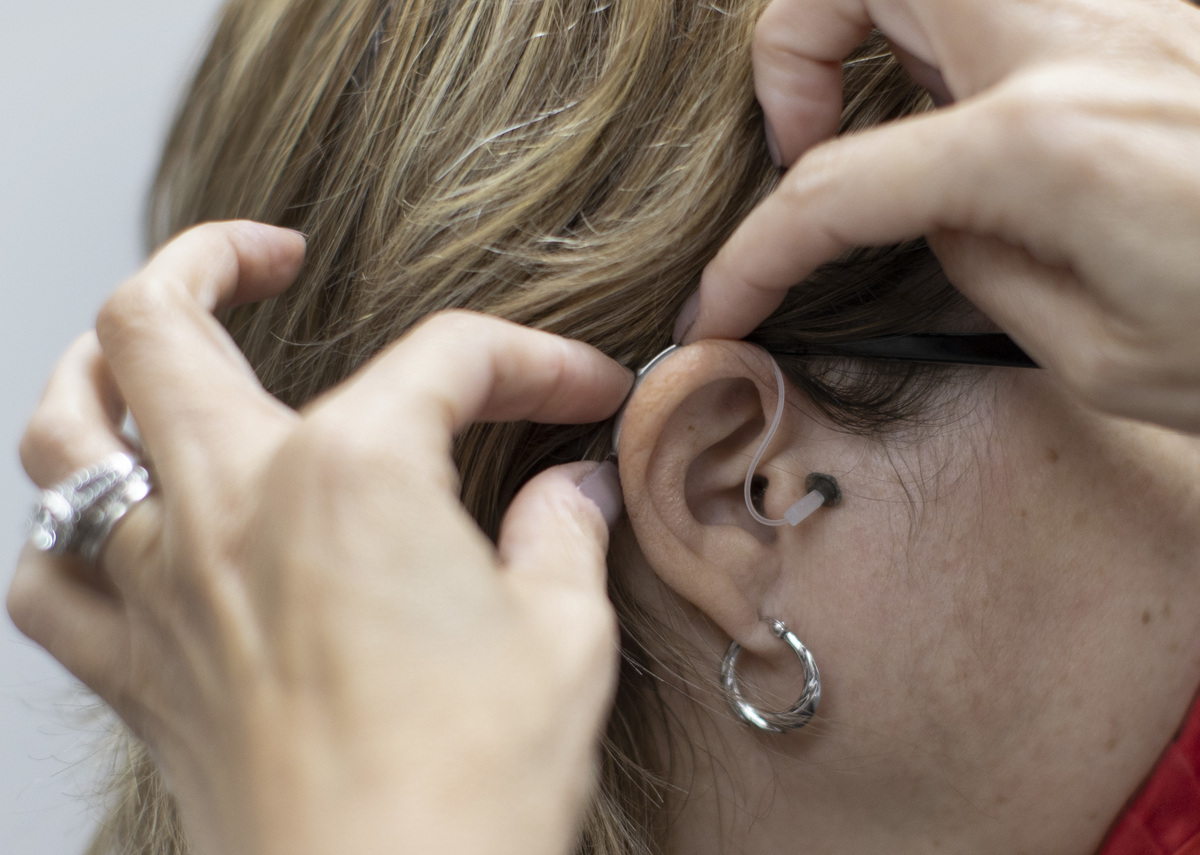Table of Contents

In this photo illustration, Janine Ramirez, a hearing aid specialist with Hear Again America, places a hearing aid on an ear Oct. 20, 2021, in Fort Lauderdale, Fla.
Joe Raedle/Getty Images
hide caption
toggle caption
Joe Raedle/Getty Images

In this photo illustration, Janine Ramirez, a hearing aid specialist with Hear Again America, places a hearing aid on an ear Oct. 20, 2021, in Fort Lauderdale, Fla.
Joe Raedle/Getty Images
Medicare doesn’t cover hearing aids; neither do most insurance policies. That’s why advocates are welcoming a new federal rule allowing over-the-counter sales of the devices, hoping the move cuts prices and makes it easier for people with hearing loss to improve their lives.
By mid-October, consumers could see over-the-counter devices in drug stores that are far more affordable than prescription aids that routinely cost thousands of dollars, thanks to the rule the Food and Drug Administration announced on Tuesday. But many people will likely have to bear that cost alone — and that’s just one of the challenges still confronting people with hearing loss.
“We’re really excited about the market,” said Barbara Kelley, executive director of the Hearing Loss Association of America. But, she added, “we think it’s going to be confusing for consumers.”
Here’s a rundown of why the rule is being celebrated, and what problems still exist.
The new rule is a long-awaited breakthrough
“There’s 48 million people in this country with some degree of hearing loss,” Kelley told NPR, “and there’s no such thing as a small hearing loss. It can be completely disruptive to your life.”
The new rule’s promise to minimize a host of health problems was hailed by Dr. Debara Tucci, director of the National Institute on Deafness and Other Communication Disorders.
“Hearing loss is associated with dementia, increased risk of falling, reduced mobility, depression, social isolation, and anxiety,” Tucci said on her federal agency’s website.
Wearing hearing aids can make a big difference. As the Hearing Industries Association said in an email to NPR, “8 in 10 who chose to treat their hearing loss report life-changing results.”
Prescription hearing aids are often wildly expensive
“The FDA estimates this rule will save consumers on the order of about $1,400 per individual hearing aid or over $2,800 per pair,” Brian Deese, director of the National Economic Council, said of the new FDA rule.
That’s a substantial saving for an essential item that the Hearing Industries Association says can range from under $1,000 up to $4,000 each.
The industry group notes that the actual devices usually account for only about a third of the total cost, since the process of getting a prescription hearing aid normally includes numerous visits to doctors and specialists who evaluate patients and fit, test and adjust their hearing aids.
OTC aids could compete with PSAP devices
By creating a new product category, the FDA is giving a regulated alternative to people who in recent years might have turned to PSAPs — or personal sound amplification products.
PSAPs are promoted as a way to amplify a normal person’s hearing. But many people who buy them aren’t hunters or private detectives — they’re just having trouble hearing, whether it’s in person or when they’re watching TV.
With the change, the PSAP category will still exist, but if their makers want to sell a device as an OTC hearing aid, they’ll have to fulfill the FDA’s quality and labeling standards.
“The truth is, in that category, there are some very good devices that will cross over to the over-the-counter market and meet the criteria,” Kelley said. “The difference is they can now market them to people with hearing loss.”
Medicare does not pay for hearing aids
“Medicare doesn’t cover hearing aids or exams for fitting hearing aids,” the government program’s website states. “You pay 100% of the cost for hearing aids and exams.”
Many Americans might be surprised that the federal insurance program doesn’t offer help to people who are most likely to need hearing aids. But it’s by design.
“Back when the law was enacted in 1965, hearing aids were not only not in there, they were statutorily excluded,” Kelley said.
Other components of modern insurance, such as dental and vision coverage, were similarly left out of the original law — although in today’s system, some Medicare Advantage plans do include coverage for those costs.
Kelley says several ideas are behind the exclusion, including a belief in 1965 that problems like hearing loss weren’t major health issues. Average U.S. lifespans were also shorter — and as we now live longer, many of us are doing so in noisier environments that progressively harm our ability to hear.
Lawmakers made headway to include hearing aids in Medicare coverage in recent years, but a House-approved bill in 2019 failed to advance in the Senate. Attempts to include the requirement in the Democrats’ Build Back Better framework also foundered.
Using hearing aids isn’t as easy as putting on reading glasses
The new class of over-the-counter hearing aids is meant to help adults with mild to moderate hearing loss. But for anyone who thinks getting an OTC hearing aid will help them as easily as snagging a pair of cheap reading glasses boosts their sight, Kelley warns that it isn’t that simple.
“That’s a good analogy,” she said, “except I’d like to clarify that when we put on glasses, typically they correct our vision. When you put on a hearing aid, it doesn’t always correct your hearing.”
That’s because many hearing loss cases are highly individualized, with problems linked to specific frequencies or environments.
“Hearing loss is unique to each person, and most do not know if their condition is mild, moderate, or greater, caused by another medical issue or something as simple as ear wax,” Hearing Industries Association President Kate Carr said in an emailed statement.
While many people might benefit from an OTC product, others might need to see a doctor and an audiologist for more sophisticated care, Carr and others say.
The chance that some consumers might rely on trial-and-error to find a device that works well for them led some commenters on the FDA proposal to ask the agency to ensure they can easily return or exchange OTC hearing aids. The FDA declined to do so, citing existing consumer laws. But its final rule does require manufacturers to clearly state their return policies.
If you buy a hearing aid without a prescription, the Hearing Industries Association says you should hang on to your receipt and be aware of the device’s warranty and return details. It also cautions consumers against using devices that over-amplify sound, as too much volume could harm their hearing further.
The rule meets a mandate set in 2017
Despite the limit on Medicare coverage, the OTC rule comes as a highly anticipated victory, arriving five years after Congress voted in in 2017 to require the FDA to create an OTC category for hearing aids.
Regulators were prodded to take action last summer, when President Biden issued a wide-ranging executive order to promote more competition. It tasked the Department of Health and Human Services with proposing an OTC hearing aid rule, setting a new timeline in motion.








More Stories
Mushroom Gummies: Do They Actually Deliver?
A dermatologist’s pre-wedding skincare timeline for looking your best
Three incumbents, two challengers running for Havre de Grace City Council; Mayor Martin will be unopposed in May 4 election